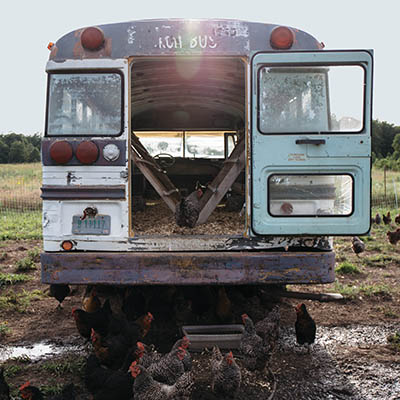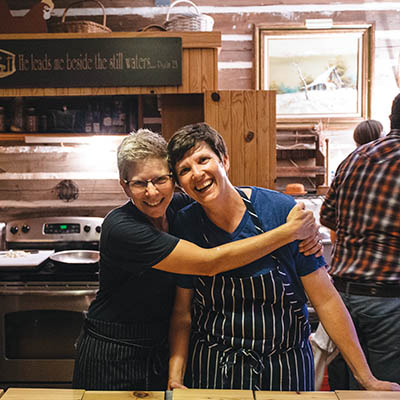Pecking, rooting, grazing
Living Kitchen’s pursuit of The Perfect Meal
Photos by Hans Kleinschmidt
Rocks fly from beneath the wheels of the car as it rumbles up the gravel drive.
We bounce through a clearing and can just barely make out signs of farm life in the distance: fencing, ponds, leafy trees with their branches stretched wide. The smell of the grass and dirt comingles with the hot summer air—eau de sunshine. A goat bleats somewhere in the distance, and a white, fur-matted farm dog trots over and pants expectantly at my car door, waiting to welcome me to the homestead. The farm is alive and well.
We make our way over to a pen full of Nubian goats and meet the crowd snapping Instagram shots around them. Even I am powerless to the mug of a baby animal, and we pose for glamour shots as we await the tour.
Linda Ford welcomes us with the warmth of family and gives us the run-down on Living Kitchen Farm & Dairy, a farm in Depew, OK helmed by Ford and Chef Lisa Becklund, now in its tenth year. The monumental anniversary will be celebrated all summer long, but special attention has been given to this dinner in particular, titled “Pecking, Rooting, and Grazing.” Combining elements from all facets of the operation—chickens, vegetables, pigs, goats, fruits and nuts—it’s as much a showcase of the farm’s finest bounty as it is homage to the animals and plants living on it.
Tonight’s menu offers nods to all of this: Pickles and Pork, made with pork belly, fermented cabbage, and pickled root vegetables, has a salty bite and brilliant color; Rooting, a dish of tri-colored carrots and a deep, cumin-y hit of masala; Pecking, a garlic and onion-heavy chicken-scratch medley of marinated eggplant, fire-roasted cauliflower florets, and life-giving corn; Grazing, a simple but explosive kale salad accented with toasted pecans, milky pillows of handmade goat cheese, and juicy heirloom tomatoes we ourselves harvested from the garden rows hours earlier; and The Pig that Went to Market, a sweet, smoky carrot mash, a bed of tart slaw and tempura-fried kale served alongside a quintessential, classic Okie favorite: pork loin. As Lisa tells it, the menu’s theme is really about that sweet spot where everything comes together—“a celebration of our existence,” as she puts it.

There’s a growing trend in our culture to put distance between the things we eat and the hands that prepare them; we see it in the standoffish unattainability that shrouds master chefs and five star restaurants, in the bulky, commoditized products that line grocery store shelves, in the way that we truck specialized fruits from one side of the country all the way to the other, in the impersonal grossness of fast food dollar menus, and in buying product from faceless wholesale suppliers to cut back on costs. We have become so conditioned to expect the bare minimum from our food that our minds are blown away when we get the crème de la crème—in this case, a freshly-picked summer squash still flecked with dirt, or a piece of cheese made from the milk of a happy goat.
Living Kitchen’s farm table dinners put this practice onto plate through a commitment to only prepare produce, dairy, and meats harvested onsite or nearby—often GMO free and certified organic. By capitalizing on this reality, they’re letting food in its purest form be the star of the show: no gimmicks, no preservatives, no crap on top—just beautiful, vibrant, artfully prepared, Oklahoma-grown bounty.
Upholding a steadfast commitment to the “grow your own” movement lets Lisa and Linda live out another aspect of their food philosophy—a Buddhist approach to eating that aims to create “the perfect meal.”
“You’ve got a certain amount of happiness and passion and love and karma and suffering, and it’s all equally part of the perfect meal,” Lisa explains. “And you know, that perfect meal is actually just the privilege of living on this planet, so that’s sort of my journey, and I think our journey together is trying to create that perfect meal in everyday life, where work is also our practice.”
.jpg)
Picture the happiest dinner you’ve ever attended, dotted with strangers gathered together for the same joyful cause: a celebratory meal on the balmy, firefly-lit porch of the Living Kitchen cabin.
The guests sit side by side, huddled around a table set for temporary royalty, sipping wine and politely chatting the evening away in anticipation of dinner.
Eventually, the courses begin to arrive: inventive dishes styled according to necessity and flair, vibrant in both color and presentation.
They are small but delicious, and the wine flows, and all of a sudden, the conversation isn’t so much polite as it is easy: new friends chatting over dinner, trying each other’s drinks, having the world’s best communal first date, gathered together for one shared purpose: to connect through food—with the chefs, with the land, and with each other.
“There’s no question for me that it is a spiritual thing,” Linda insists. “It’s not overt, and I think many people may not necessarily be able to put words to it, but … it opens them up. It’s slowing down.
“I mean, breaking bread, you know, in that language, that in itself is such a privilege...” Lisa offers. As she trails off, you can see the wheels turning in her eyes, as if imagining the dinner coming together, and that sense of sharing getting transferred from one guest to another.
“So, yeah, it’s hard not to think about that in every step of what we do.”
Lisa and Linda are careful to create an environment where that sort of authentic sharing can unfold, without being too heavy-handed. It pops up in the delicately-scrawled placards that await guests at their seats, the summery candles, mason jars, tea lights and fireflies that set the ethereal ambiance of the back porch, in the fortuitous scent of the trees and the dirt and the fragrant air, in the small, focused staff, and in the contemplative nature of the cabin itself.
.jpg)
Originally from the Pacific Northwest, Lisa culled her skills in some of Seattle’s finest slow-food, farm-to-table establishments.
Armed with a dream of launching her own, she headed to Oklahoma to get deeper into the weeds of the farming component of cooking, growing everything herself and selling it at local farmers markets. And although Living Kitchen has since built a rabid and loyal following, the road to that success was riddled with potholes—so much so that Lisa almost called it quits on the dream altogether.
“Some years ago, I really had to do a bit of soul searching. Farming was really hard, and it was a lot of failure. I couldn’t see the results, and I started getting really depressed thinking, oh my god I just need to go to a restaurant where it’s easy. But I needed to find a greater purpose in what I was doing.”
With sales at the farmers market not panning out, Lisa decided to create a more intimate alternative. She called on her network and invited them out to the farm for a dinner on her porch.

The work was tough, but the community followed instantly. Ten years later, Living Kitchen’s community still rallies behind the organization to sell out nearly 50 farm table dinners between the months of April and October, each placed for a group of 36, designed to preserve that same intimacy that sparked Living Kitchen’s initial success.
“Sometimes I don’t even know what the menu’s going to be until four that afternoon,” Lisa admits. “Or we might have a terrible thunderstorm, or it might be a little chillier than normal … nobody knows the drill.”
This type of on-the-fly innovation takes specific planning: leafing through seed catalogs to find the perfect mix of new and heirloom varieties, selecting and sowing them months in advance, timing their sprouting to match the menus of a still-undecided themed dinner schedule, and when that schedule arrives, using them in a way that helps diners see them in a new light.
But guests have to ante up with a certain bit of flexibility, too. Reservations are made months in advance, often on a sight-unseen basis with little idea of what to expect. When the date finally rolls around, guests flock to the farm with astonishingly open minds. For many, the visit marks their first ever to a working farm, and they arrive bright-eyed and curious, almost childlike in their excitement. That excitement translates to willingness—to try something new, to be shuffled around in the seating chart, and to be open to whatever improvised idea or whim Lisa decides to chase. It’s a deep indulgence of curiosity, and Linda suspects it might be this very unknown that people find so appealing.
Tonight, the “Pecking, Rooting, and Grazing” menu marries focus with flavor, skipping back and forth between ultra-rich courses such as a buttery potato gnocchi and light, surprising palette cleansers like the hibiscus and rose-infused ice. Everything is fresh, everything tastes incredible, and everything is made with purpose.
It’s hard to imagine a better evening out in Oklahoma, and when you’re sitting on that breezy porch in the heat of summer, it’s hard to imagine winter overtaking the farm. Still, when the first freeze creeps in, Living Kitchen will close up shop for the season and Linda and Lisa will begin planning the next year of culinary creations. And while there’s only so much a one-chef operation can support, Lisa and Linda have toyed with the idea of adding more casual, five-course Sunday dinners to their schedule to accommodate new guests. It might be a ways away, but like the dinners have proved time and time again, anticipating the payoff is half the fun.
All regularly scheduled 2016 dinners are currently sold out, but interested diners can get on the wait list for certain seatings, or subscribe to the mailing list for last-minute openings.
LivingKitchenFarmandDairy.com
For more from Megan, read her Tour de Pho.


.jpg)
.jpg)
